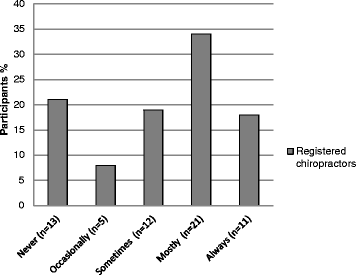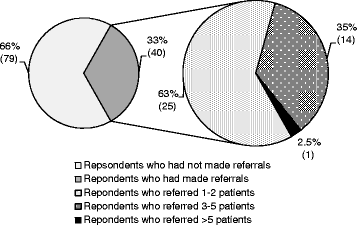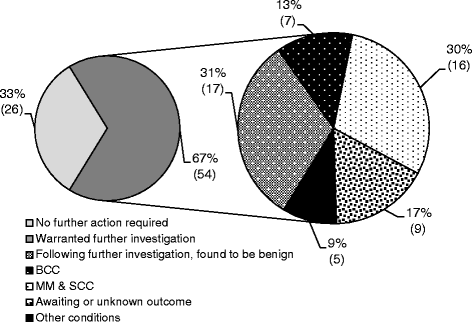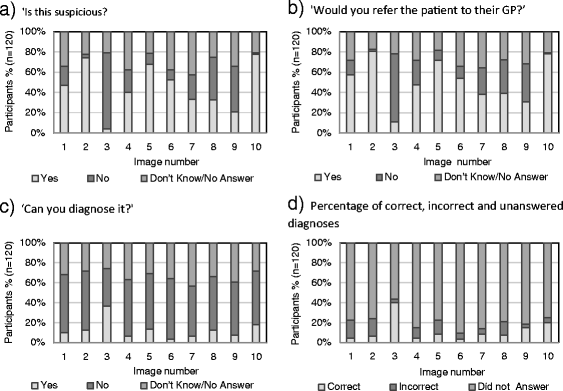Public health engagement: detection of suspicious skin lesions, screening and referral behaviour of UK based chiropractors
- PMID: 25648692
- PMCID: PMC4314793
- DOI: 10.1186/s12998-014-0047-2
Public health engagement: detection of suspicious skin lesions, screening and referral behaviour of UK based chiropractors
Abstract
Background: UK morbidity and mortality rates from skin cancer are increasing despite existing preventative strategies involving education and early detection. Manual therapists are ideally placed to support these goals as they see greater quantities of exposed patient skin more often than most other healthcare professionals. The purpose of this study therefore was to ascertain the ability of manual therapists to detect, screen and refer suspicious skin lesions.
Method: A web-based questionnaire and quiz was used in a sample of UK chiropractic student clinicians and registered chiropractors to gather data during 2011 concerning skin screening and referral behaviors for suspicious skin lesions.
Results: A total of 120 questionnaires were included. Eighty one percent of participants agreed that screening for suspicious skin lesions was part of their clinical role, with nearly all (94%) assessing their patients for lesions during examination. Over 90% of the participants reported regularly having the opportunity for skin examination; with nearly all (98%) agreeing they would refer patients with suspicious skin lesions to a medical practitioner. A third of respondents had referred a total of 80 suspicious lesions within the last 12 months with 67% warranting further investigation.
Conclusions: Nearly all respondents agreed that screening patients for suspicious skin lesions was part of their clinical role, with a significant number already referring patients with lesions.
Keywords: Chiropractor; Dermatology; Detection; Manual therapist; Prevention; Referral behaviour; Screening; Skin cancer; Skin lesion.
Figures




Similar articles
-
A Survey of Licensed Massage Therapists' Perceptions of Skin Cancer Prevention and Detection Activities.Int J Ther Massage Bodywork. 2018 Dec 1;11(4):4-10. eCollection 2018 Dec. Int J Ther Massage Bodywork. 2018. PMID: 30524632 Free PMC article.
-
Dental screening and referral of young children by pediatric primary care providers.Pediatrics. 2004 Nov;114(5):e642-52. doi: 10.1542/peds.2004-1269. Pediatrics. 2004. PMID: 15520094
-
Chiropractic radiologists: a survey of chiropractors' attitudes and patterns of use.J Manipulative Physiol Ther. 1997 Jun;20(5):311-4. J Manipulative Physiol Ther. 1997. PMID: 9200045
-
Skin cancer knowledge, attitudes, and practices among non-medical skin care professionals: A narrative review of cross-sectional and interventional studies.J Cosmet Dermatol. 2021 Aug;20(8):2437-2457. doi: 10.1111/jocd.14260. Epub 2021 Jun 10. J Cosmet Dermatol. 2021. PMID: 34047438 Review.
-
Chiropractic in The Netherlands: a survey of Dutch chiropractors.J Manipulative Physiol Ther. 1995 Mar-Apr;18(3):129-34. J Manipulative Physiol Ther. 1995. PMID: 7790791 Review.
Cited by
-
Skin cancer concerns particular to women.Int J Womens Dermatol. 2015 Sep 16;1(3):123-125. doi: 10.1016/j.ijwd.2015.07.002. eCollection 2015 Aug. Int J Womens Dermatol. 2015. PMID: 28491974 Free PMC article. Review.
-
Suicide prevention, public health, and the chiropractic profession: a call to action.Chiropr Man Therap. 2021 Apr 14;29(1):14. doi: 10.1186/s12998-021-00372-7. Chiropr Man Therap. 2021. PMID: 33853629 Free PMC article.
-
Primary prevention in chiropractic practice: a systematic review.Chiropr Man Therap. 2017 Mar 20;25:9. doi: 10.1186/s12998-017-0140-4. eCollection 2017. Chiropr Man Therap. 2017. PMID: 28321293 Free PMC article. Review.
-
Skin cancer concerns particular to women.Int J Womens Dermatol. 2017 Feb 16;3(1 Suppl):S49-S51. doi: 10.1016/j.ijwd.2017.02.009. eCollection 2017 Mar. Int J Womens Dermatol. 2017. PMID: 28492039 Free PMC article. Review.
-
Chiropractic care and skin health: a partnership for early melanoma detection.J Can Chiropr Assoc. 2025 Apr;69(1):16-18. J Can Chiropr Assoc. 2025. PMID: 40511286 Free PMC article. No abstract available.
References
-
- Cancer Research. Cancer Statistics. http://info.cancerresearchuk.org/Cancerstats/Types/Skin 2011a; [Accessed 22/09/11].
LinkOut - more resources
Full Text Sources
Other Literature Sources

